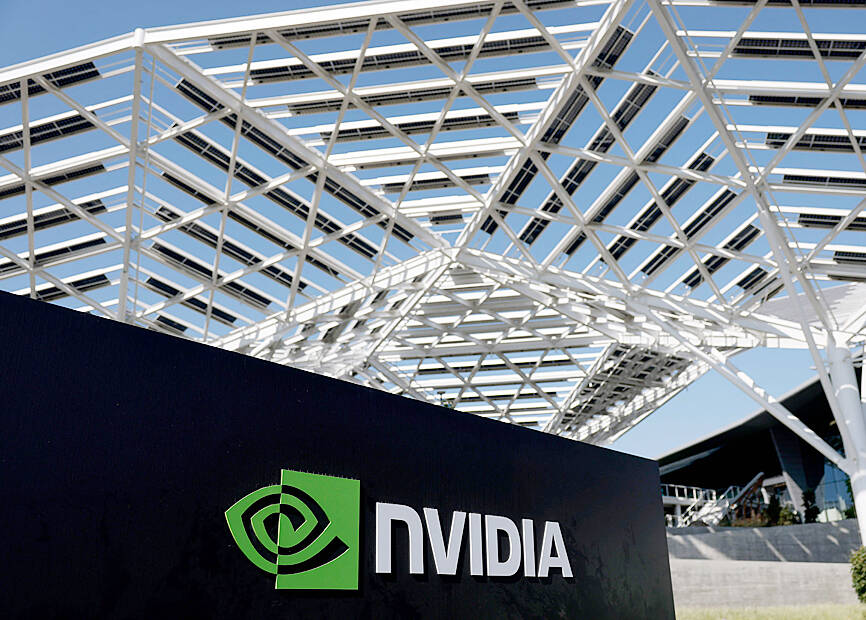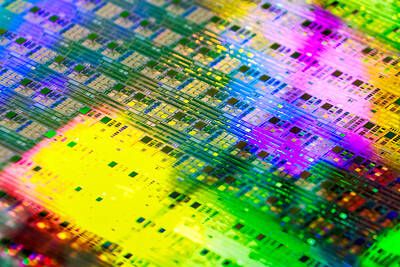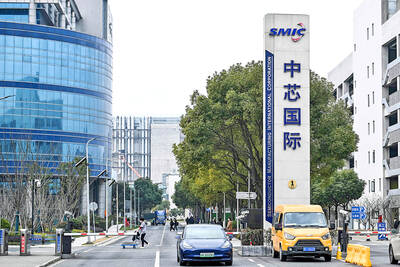Nvidia Corp chief executive officer Jensen Huang (黃仁勳) on Wednesday dismissed concern about an end to a spending boom on artificial intelligence (AI) chips, projecting opportunities would expand into a multitrillion-dollar market over the next five years.
Huang sought to reassure investors rattled by indications of slowing growth at the chipmaker at the center of the investment frenzy. Nvidia earlier in the day forecast its fiscal third-quarter revenue meeting analyst estimates, but short of the lofty expectations that have sent its share price up about one-third this year.
Its fiscal second-quarter results came up short of some analyst expectations in its important data center segment, with some analysts suggesting cloud computing providers might be more cautious about spending.

Photo: AFP
Nvidia also said it has not assumed any shipments of its H20 chips to China in its outlook, despite having earlier this month received some licenses to sell them. If geopolitical issues subside and it gets more orders, Nvidia said that it could add US$2 billion to US$5 billion in H20 revenue in the third quarter.
Huang’s bullish outlook contrasts with recent signs of fatigue in AI-focused stocks and comments from industry leaders about overheated investor enthusiasm.
“A new industrial revolution has started. The AI race is on,” Huang said. “We see US$3 trillion to US$4 trillion in AI infrastructure spend by the end of the decade.”
Pushing up the chipmaker’s shares are expectations of demand from big tech, data center owners known as hyperscalers and China.
While Nvidia shares have outpaced an about 10 percent gain on the broader market, AI-facing stocks have shown signs of fatigue.
OpenAI chief executive officer Sam Altman set off alarm bells this month when he said investors might be “overexcited” about AI.
Huang sounded unperturbed.
“The more you buy, the more you grow,” Huang said, arguing that Nvidia’s technological advances allow customers to process increasing amounts of data while using less energy.
“The buzz is: everything sold out,” he said.
Case in point: A customer outside China bought US$650 million of Nvidia’s H20 reduced-capability chips aimed at the Chinese market in the latest quarter, the chipmaker said.
Huang based his forecast in part on the US$600 billion he expects for data center capital spending this year from major customers such as Microsoft Corp and Amazon.com Inc.
For a data center costing as much as US$60 billion, Nvidia can capture about US$35 billion, he said.
Huang’s remarks contrast with a tepid third-quarter sales forecast of about US$54 billion, slightly ahead of the US$53.14 billion average of analyst estimates compiled by LSEG.
Nvidia and Huang see little reason for AI chip profit growth to slow as its fiscal second-quarter net profit of US$26.4 surpassed that of its peer Apple Inc. The company reported revenue of US$46.74 billion for the second quarter, beating estimates of US$46.06 billion.
The company’s high-end Blackwell chips are largely spoken for based on next year’s forecasts from its biggest customers. Its earlier-generation Hopper processors are being snapped up, too.
“When you have something that is new, and it’s growing as fast as it is, and with all of the huge capex announcements from the hyperscalers, it’s evidence that we’re in the early stages” of the AI boom, Globalt Investments LLC portfolio manager Thomas Martin said.

NO BREAKTHROUGH? More substantial ‘deliverables,’ such as tariff reductions, would likely be saved for a meeting between Trump and Xi later this year, a trade expert said China launched two probes targeting the US semiconductor sector on Saturday ahead of talks between the two nations in Spain this week on trade, national security and the ownership of social media platform TikTok. China’s Ministry of Commerce announced an anti-dumping investigation into certain analog integrated circuits (ICs) imported from the US. The investigation is to target some commodity interface ICs and gate driver ICs, which are commonly made by US companies such as Texas Instruments Inc and ON Semiconductor Corp. The ministry also announced an anti-discrimination probe into US measures against China’s chip sector. US measures such as export curbs and tariffs

The US on Friday penalized two Chinese firms that acquired US chipmaking equipment for China’s top chipmaker, Semiconductor Manufacturing International Corp (SMIC, 中芯國際), including them among 32 entities that were added to the US Department of Commerce’s restricted trade list, a US government posting showed. Twenty-three of the 32 are in China. GMC Semiconductor Technology (Wuxi) Co (吉姆西半導體科技) and Jicun Semiconductor Technology (Shanghai) Co (吉存半導體科技) were placed on the list, formally known as the Entity List, for acquiring equipment for SMIC Northern Integrated Circuit Manufacturing (Beijing) Corp (中芯北方積體電路) and Semiconductor Manufacturing International (Beijing) Corp (中芯北京), the US Federal Register posting said. The

India’s ban of online money-based games could drive addicts to unregulated apps and offshore platforms that pose new financial and social risks, fantasy-sports gaming experts say. Indian Prime Minister Narendra Modi’s government banned real-money online games late last month, citing financial losses and addiction, leading to a shutdown of many apps offering paid fantasy cricket, rummy and poker games. “Many will move to offshore platforms, because of the addictive nature — they will find alternate means to get that dopamine hit,” said Viren Hemrajani, a Mumbai-based fantasy cricket analyst. “It [also] leads to fraud and scams, because everything is now

MORTGAGE WORRIES: About 34% of respondents to a survey said they would approach multiple lenders to pay for a home, while 29.2% said they would ask family for help New housing projects in Taiwan’s six special municipalities, as well as Hsinchu city and county, are projected to total NT$710.65 billion (US$23.61 billion) in the upcoming fall sales season, a record 30 percent decrease from a year earlier, as tighter mortgage rules prompt developers to pull back, property listing platform 591.com (591新建案) said yesterday. The number of projects has also fallen to 312, a more than 20 percent decrease year-on-year, underscoring weakening sentiment and momentum amid lingering policy and financing headwinds. New Taipei City and Taoyuan bucked the downturn in project value, while Taipei, Hsinchu city and county, Taichung, Tainan and Kaohsiung